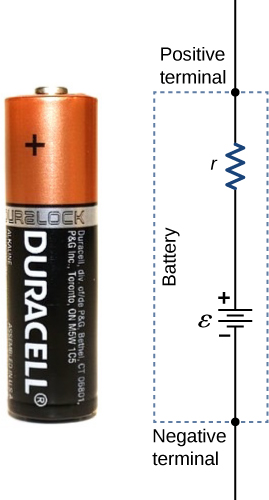OCR Specification focus:
‘Energy transfer in circuits: W = VQ and W = EQ for charges moved by p.d. or e.m.f..’
Energy Equations in Electrical Circuits
Energy transfer within electrical circuits is fundamental to understanding how electrical systems function. This subsubtopic explores how electrical energy relates to potential difference and electromotive force (e.m.f.), expressed through the key relationships W = VQ and W = EQ. These equations describe how energy is either transferred or supplied when an electric charge moves through a potential difference or source of e.m.f.
The Concept of Energy Transfer
Whenever an electric charge moves in a circuit, energy is transferred between electrical components. The amount of energy transferred depends on the potential difference (p.d.) across the component and the charge that moves.
Potential Difference (p.d.): The energy transferred per unit charge as charge moves between two points in a circuit.
When charges pass through a component such as a resistor or lamp, they lose energy which is converted into other forms like heat or light. This is a potential difference—energy leaving the electrical system.
In contrast, when charges pass through a source such as a battery or cell, they gain energy. This is described by the electromotive force (e.m.f.), representing energy supplied to the circuit.
Electromotive Force (e.m.f.): The energy supplied per unit charge by a source to drive current around a circuit.
Both p.d. and e.m.f. are measured in volts (V), where 1 volt equals 1 joule per coulomb (1 V = 1 J C⁻¹).
The Energy Equation W = VQ
The first key energy relationship for circuits expresses how much energy is transferred when a charge moves through a potential difference.
EQUATION
—-----------------------------------------------------------------
Energy Transfer (W) = Potential Difference (V) × Charge (Q)
W = VQ
W = Energy transferred (joules, J)
V = Potential difference (volts, V)
Q = Charge (coulombs, C)
—-----------------------------------------------------------------
This equation shows that the energy transferred to or from a charge is directly proportional to both the size of the potential difference and the amount of charge that flows.
For example, if a large charge moves through a high potential difference, the total energy transferred will be greater. In real circuits, this energy might appear as heat, light, or mechanical energy depending on the component.
Relating W = VQ to E.m.f.
The same mathematical relationship applies when considering a source of e.m.f. instead of a potential difference across a load. The equation is then written as W = EQ, where E represents the electromotive force.
EQUATION
—-----------------------------------------------------------------
Energy Supplied (W) = Electromotive Force (E) × Charge (Q)
W = EQ
W = Energy supplied (joules, J)
E = Electromotive force (volts, V)
Q = Charge (coulombs, C)
—-----------------------------------------------------------------
This form highlights how an energy source provides energy to the circuit. As charge flows through the source, it gains electrical potential energy, which can later be converted into other forms within circuit components.
In essence, W = VQ describes energy transferred by a component, whereas W = EQ describes energy supplied to the circuit by a source.

A labelled battery model shows emf ε in series with internal resistance r feeding a load R. The source does work per coulomb E on charge, while the load has a potential difference V across it. The inclusion of r (internal resistance) is extra detail beyond this subsubtopic but clarifies why the terminal p.d. can differ from emf. Source.
Understanding the Physical Meaning
Each coulomb of charge carries an amount of energy determined by the voltage through which it moves. This relationship connects the microscopic motion of charges with macroscopic quantities such as current, voltage, and power.
When charges lose energy as they move through a resistor, that energy is transferred as thermal energy.
When charges gain energy in a cell, that energy originates from chemical reactions inside the source.
These processes occur simultaneously around the circuit, conserving energy overall — what is supplied equals what is transferred and dissipated.
Linking Charge Flow, Energy, and Current
To link these ideas to current, recall that current (I) is the rate of flow of charge. Therefore, the total charge moving in a given time t is Q = It. Substituting this into the energy equations connects energy, potential difference, current, and time.
After substitution:
For potential difference: W = VIt
For e.m.f.: W = EIt
These forms are particularly useful for analysing energy transfer over time, showing how much energy is moved in a given period when current flows.
Conceptual Differences Between V and E
Although numerically similar in units and sometimes in value, potential difference and electromotive force represent opposite roles in a circuit:
Potential Difference (p.d.): Energy lost per coulomb by charges moving through a component.
Electromotive Force (e.m.f.): Energy gained per coulomb by charges within the source.
In steady-state conditions, the sum of e.m.f.s around a circuit equals the sum of potential differences, in accordance with the principle of energy conservation.
Practical Implications in Circuits
Understanding these equations helps interpret and design circuits effectively:
In a simple circuit with a cell and resistor, the energy supplied by the cell (calculated using W = EQ) equals the energy transferred to the resistor (calculated using W = VQ).
This ensures all energy supplied is accounted for, often as heat dissipated in resistors or light emitted from bulbs.
When additional components such as sensors or diodes are included, each potential difference corresponds to a share of the total energy supplied by the e.m.f.
The equations also underpin later power relationships (such as P = VI), since power is simply the rate of energy transfer derived from these foundational ideas.
In a complete circuit, charges pass through the source and components, gaining and transferring energy according to W = EQ (at the source) and W = VQ (across components).

A minimal battery–switch–lamp circuit illustrating a complete path for charge. Use it to indicate where energy is supplied (the battery) and where it is transferred (the lamp). This diagram is intentionally simple and includes only standard circuit symbols. Source.
Summary of Core Relationships
The energy equations W = VQ and W = EQ are essential tools for understanding how energy flows in electrical systems. They quantify the energy per charge that moves through different parts of a circuit, unifying the ideas of potential difference, e.m.f., charge, and energy. By mastering these, students develop a precise understanding of how circuits operate and how electrical energy is both supplied and used in practical applications.
FAQ
The total energy supplied by the source (using W = EQ) equals the total energy transferred across all components (using W = VQ for each).
Energy conservation ensures no loss of total energy — only conversion into other forms such as heat, light, or sound.
If the circuit contains several components, each has its own potential difference, and the sum of these equals the electromotive force of the source.
Both express the same concept from different perspectives:
Volt (V) is the standard unit used in circuit equations.
Joule per coulomb (J C⁻¹) reveals the underlying physical meaning — it shows how much energy (in joules) is transferred for each coulomb of charge that moves.
Using J C⁻¹ helps connect the macroscopic quantity of voltage to the microscopic transfer of energy by charge.
Yes, but with care. The equation W = VQ still defines energy transfer per charge, but both V and Q continuously change direction in a.c. circuits.
In practice, average or root mean square (rms) values of voltage and current are used for energy and power calculations. These rms values give the equivalent steady values that would produce the same energy transfer as in a direct current (d.c.) circuit.
Charge conservation ensures that the amount of charge leaving the source equals the amount entering every component in a series circuit.
Because the same charge Q flows through all elements, the energy gained per coulomb from the source (E) is exactly balanced by the energy lost per coulomb across the loads (sum of all V values).
This direct link between energy and conserved charge underpins Kirchhoff’s Second Law, which reflects conservation of energy in electrical systems.
When current flows, energy is used to overcome the internal resistance of the cell.
The emf represents the total energy supplied per coulomb by the source’s chemical reactions.
The terminal voltage is slightly less, as some energy per coulomb is dissipated as heat within the cell.
Only under no-load conditions (open circuit) are the emf and terminal voltage equal.
Practice Questions
Question 1 (2 marks)
Define potential difference and state the equation that relates energy transferred, charge, and potential difference.
Mark Scheme:
1 mark: States that potential difference is the energy transferred per unit charge between two points in a circuit.
1 mark: Correctly gives the equation W = VQ (accept “energy = potential difference × charge”).
Question 2 (5 marks)
A battery supplies energy to a circuit. The battery has an electromotive force (emf) of 12 V and transfers a total charge of 150 C to the circuit.
(a) Calculate the total energy supplied by the battery.
(b) Explain the difference between electromotive force (emf) and potential difference (p.d.) in terms of energy transfer, using your answer to part (a) to support your explanation.
Mark Scheme:
(a) 2 marks total:
1 mark: Correct substitution into W = EQ or W = VQ.
1 mark: Correct numerical answer with unit: W = 12 × 150 = 1800 J (or 1.8 × 10³ J).
(b) 3 marks total:
1 mark: States that emf is the energy supplied per coulomb of charge by the source.
1 mark: States that potential difference is the energy transferred per coulomb of charge across a component.
1 mark: Links explanation to the calculation, e.g. “Each coulomb of charge receives 12 J of energy from the battery, which is then transferred to components as the same amount of energy per coulomb.”

